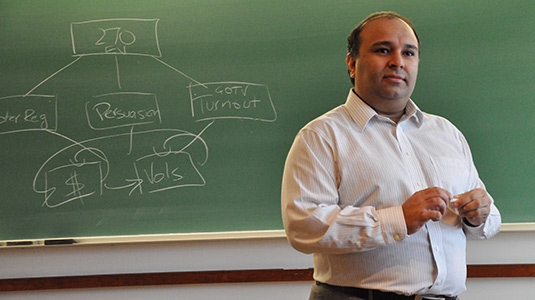Obama Chief Campaign Scientist on Data, Technology and Analytics in Elections
Rayid Ghani speaks as part of Master of Science in Analytics Lecture Series

During the recent presidential election, you may have received a phone call or home visit from a campaign worker urging you to vote, soliciting a contribution, or asking what issues were important to you. Maybe you engaged in a lengthy chat or donated money; maybe you sent the call to voicemail.
Either way, that interaction provided valuable data to the campaign. Obama for America made roughly 120 million phone calls and home visits during the 2012 presidential campaign, all of which were carefully designed to generate the maximum benefit at the least cost — and to provide campaign’s number-crunchers with information to refine their strategies. That’s because today’s elections aren’t just about ideas; they’re about efficiency.
In a presidential campaign that split the country’s popular vote 48 to 52 percent, every vote counted — and analytics played a vital role in winning them, said Rayid Ghani, chief scientist for the 2012 Obama for America campaign.
Ghani, speaking February 7 as part of McCormick’s Master of Science in Analytics Lecture Series, described how Obama for America targeted potential votes through personal interactions, voter registration drives, and advertising. Key in the process is assigning each voter a “support score,” a measure of how likely she was to vote for Obama based on information like party affiliation and public voting records. By segmenting the population by their likelihood to support Obama and to show up at the polls, the campaign could make effective decisions about where to spend its money, Ghani said.
Young voters proved to be a challenge in this election season, Ghani said, because of their low response-rate to these traditional outreach methods. “They don’t have landlines, they don’t pick up the phone,” he said. “They’re a difficult case.”
The solution: getting young supporters to canvass online. Ghani’s team developed a Facebook tool that compared a user’s “friend” list to the campaign’s database, showing the user which of their friends were likely undecided and might be convinced to vote for Obama.
There was a low threshold for success. At best, the campaign hoped to impact only 0.2 or 0.3 percent of the voting population, Ghani said — but “if distributed correctly, that could change the election,” he said.
And the phone conversation you had with that volunteer about the environment, your frustration with politics, or your son in the Army? That data also made its way into mathematical models created by the campaign to fine-tune its strategy for 2012 and future elections.
The Master of Science in Analytics program is a 15-month curriculum housed in McCormick’s Department of Industrial Engineering and Management Sciences. Applications for the 2013-14 cohort are now being accepted. For more information, visit http://www.analytics.northwestern.edu.
The Master of Science in Analytics Lecture Series continues on Tuesday, March 12 when Kurt Kendall, partner and director of analytics practice at management consulting firm Kurt Salmon, will speak on “Analytics as a Retail Growth Engine.”